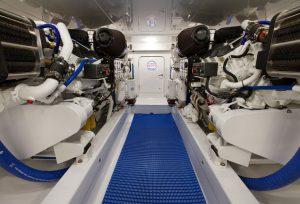Just about every customer we talk to asks, “Can I have an estimate?” It’s a simple enough request; typically, our answer is also simple, “No.”
Could we give an estimate? Well YES! We have years of experience, we have access to all of the parts catalogs, and we know our labor rate, so Yes, we could give an estimate. However, in our experience, estimates only serve to do one thing, make an unhappy customer.
First, let’s look at the definition of “Estimate”
es·ti·mate
verb
/ˈestəˌmāt/
roughly calculate or judge the value, number, quantity, or extent of.
The marine repair industry is somewhat unique in the challenges it presents. Let’s look at the elements that go into a marine repair job.
Access

Just getting to a boat can be a challenge. Boats are typically in the water at a marina. In order to get to the boat to do the job, there is drive time from the office to the marina. Once at the marina, most marinas require contractors to check in at the office and, in some cases, pay a fee. If you own a boat, you know how long the walk down the dock to your boat is, especially when carrying heavy tools.
Once on the boat, gaining access to the engine can be time-consuming. On many boats, there are furniture and carpets in the way that must be moved. Often basic access can be gained through a hatch, but in some cases, floor panels must be removed. Okay, now you can see the engine!

With few exceptions, boat manufacturers typically try to minimize the space used to house the engine. Stand-up engine rooms with walk-around space exist, but typically only in larger boats. This means crawling into the cramped, frequently hot and smelly area on hands and knees. Especially on twin-engine boats, gaining access to the outboard side of the engine requires crawling up and over or around the engine. With some manufacturers, accessing parts on the outboard side can require moving the engine!
Overall Condition
When looking at a repair job on a boat, the overall condition of the boat and engine plays a major role in the estimation process. Boats that are clean and well-maintained allow our technicians to evaluate faults quickly. A clean engine allows you and our technicians to more easily identify leaks, discoloration of parts, and broken or missing components. When an engine is dirty, the bilge is full of oil and water, and the components are rusted. Identifying the source of a fault can be difficult, if not impossible.
The condition also plays a role in the amount of time a repair will take. Rusted bolts, oily surfaces, and poorly maintained components take much more time to remove and sometimes fail during the removal process.
The Marine Environment
Boats, by design, live in water. Boat engines, transmissions, and their related components are made primarily of metal. This leads to corrosion through exposure to water, especially salt water, and electrolysis, where electrical current through the water or between dissimilar metals eats away at components.
Because most marine engines are cooled with water drawn in from the surrounding environment, aquatic plants and animals are also drawn in and can clog or damage. Unfortunately, an external inspection of your boat’s systems rarely shows issues from internal clogging of heat exchangers and air conditioning systems.
Diagnosis
Sometimes issues are very straightforward and easy to diagnose. As with vehicles, frequently issues are intermittent, and diagnosis can take time, including sea trials, extended run times, or in some cases, disassembly of components. Additionally, we often need advanced testing tools such as bore scopes, pressure testers, or engine scanners. These tools are expensive, and we don’t typically carry them with us to a boat, so we will need to make that long walk back up the dock and sometimes a drive back to the shop to get them.
Time spent diagnosing an issue is billable, as it’s part of the repair. It is nearly impossible to predict how long tracking down a problem will take. Sometimes it’s a few minutes; other times it can take hours.
We have years of experience and hundreds of hours of manufacturer training. It frustrates us when a customer calls, explains an issue, and we give a diagnosis based on our limited information, then the customer argues with us. You called a professional for a reason! If when we can diagnose the issue on-site, we are wrong, we will happily let you know! Remember, if it were easy, you wouldn’t be calling us!
Parts
Over the last few years, parts for just about anything have become harder to obtain, and manufacturers are constantly increasing prices. In January of 2023, several of the major marine engine manufacturers increased prices by over 15%. Prices change on an almost daily basis. If we quote a part and don’t order it the same day, it is possible that the parts price will increase.
For most manufacturers, we pay when we order parts. With frequent parts price increases and short availability, if there is a delay in shipping due to lack of availability, the manufacturer will charge us the difference between the price when we ordered and when they ship.
As you can understand, this makes providing an accurate estimate very difficult.
While on the subject of parts availability, the issues with the supply chain have resulted in lead times for some parts to exceed 18 months. Manufacturers are also discontinuing parts for older models in an effort to reduce costs.
Labor Rate
This is probably the hardest part of a job to estimate. There are so many unknowns in the marine environment.
Labor rates have a large number of components. Many that the average customer is not aware of. Within our labor rate, we need to cover our operating costs. Here is a list of the major items:
- Service Vehicle -purchase, maintenance, taxes, license, and tools.
- Specialty Tools – we have over a million dollars invested in tools!
- Equipment – Engine hoists, diagnostic testing gear, heavy lifting equipment.
- Training – Manufacturers require annual training and certification, which involves the cost of the classes, travel, hotels, meals, etc.
- Dealership Fees – We pay a yearly fee to each manufacturer to maintain our dealership and access parts and service support.
- Parts Inventory – Most manufacturers require that we purchase a minimum value of parts each year. We have an extensive inventory of the most common maintenance parts.
- Taxes – Federal, Payroll, State, and Local taxes.
- Insurance – Business insurance, vehicle insurance, and health coverage for our employees.
- Environmental Fees – The state and many municipalities charge us environmental impact fees.
- Building – Real estate taxes, Insurance, Utilities. We have a complete machine shop, a woodworking shop, and a parts warehouse. We are not “Shade Tree Mechanics.”
- Salaries – Salaries of our technicians, parts manager, and office staff.
Recently we were replacing the exhaust gaskets on a Yanmar engine. Usually a fairly straightforward job. Remove an overflow tank, disconnect the exhaust riser, remove 12 bolts, clean up the block and exhaust manifold surfaces, install the new gaskets, and re-assemble. All was going well until we started torquing the bolts back in. One of them had been over-torqued at the factory and snapped when we re-torqued it. Fortunately, we were able to remove the broken bolt without drilling. We had to re-order new gaskets as they are crush style and not reusable, and when we tried to order replacement bolts (if one broke, we were not going to risk just replacing that one and ordering 12). Yanmar didn’t have any and had no estimate on when (or even if) they would get them back. It took several hours of searching to find suitable replacements (length, pitch, hardness), and we had to wait a week for the replacement parts to arrive. This meant packing up tools and leaving the boat and making a return trip. In the end, it cost the customer an additional 6 hours of labor, plus the parts. Aside from having a crystal ball (if you know where we can get one that works, please let us know), somewhat common situations like this are nearly impossible to predict.
Guess, Take Advantage, or Tell The Truth?
So, as a boat owner, which would you prefer? We can give you a guess, which, more often than not, will not be accurate. As the vendor, we never catch a break.
If we estimate $20,000 and it comes in at $10,000, then we over-quoted, and, in many cases, the customer will go with another provider who estimates $10,000 and ends up charging more.
If we estimate $10,000 and come in higher, the customer is angry that it was more expensive than estimated and is unhappy, saying, “you said it would only cost $10,000!”.
We could take advantage and estimate $30,000 and charge $30,000 even when the final bill would only be $10,000. While common, we think this is unfair to you, the customer.
We would rather be honest and up-front with our customers and say that we genuinely don’t know what the job will finally cost. We can give wide ranges, but a firm “estimate” is usually inaccurate and serves no purpose aside from causing friction with you, our customer. We prefer to be open and honest.
How We Do Business
We feel that communication and cooperation are key to a successful repair. We are open and honest with our customers. When our technicians go on a boat, we evaluate the requested fault but also do a full systems review. Frequently, a specific fault is related to a more ubiquitous issue and affects other systems on the boat.
Some customers get upset that we are “picking” on the boat, far from it. We want our customers to have a safe, trouble-free, causing experience. If we see something that is a potential fault or is due for maintenance, we feel strongly that it is our duty to point it out. There is nothing worse than paying for a repair, leaving the dock, and having some other systems fail.
We feel that it is our responsibility to help our customers keep their boats in top condition rather than risk potentially larger repairs in the future. We regularly see significant repairs and engine replacements or rebuilds that could have been prevented with early intervention and proactive maintenance.
In the end, it is your decision as the owner of your vessel whether you perform recommended maintenance. Our technicians will send you a text message each day with the tasks performed on your boat, the hours worked, and photos or videos for your review. If you feel that a project is exceeding your expectations, we will work with you to manage the project to the best of our abilities.
We respond to most requests 24/7. Our prior customers will attest to our availability. We regularly drive to marinas or provide phone support on weekends, evenings, or even at 2 am!
Don’t Shoot The Messenger!
In the end, your long-term plans for your boat, budget, and tolerance for risk determine the investment you are willing to make in your boat. We, like you, are at the mercy of the manufacturers and their pricing and availability policies. We will communicate with you about availability and pricing changes.
We will be open and honest with you on the condition of your boat’s systems and recommend the repairs. We will specify those that are critical, prudent, and/or recommended by the manufacturers. In the end, it is your decision what work we do. We are not trying to rip you off or create work. We truly want your “Pleasure Boating” to be “Pleasureable”!
What we ask is that you, as a responsible boat owner, be reasonable, responsive, and understanding that some aspects of your boat’s maintenance and repair are outside of our control. We’ll tell you the truth just “Don’t Shoot The Messenger.” We have your best interests at heart!
Remember, while diagnostic technology is getting better every day, we still don’t have a Crystal Ball that allows us to see into your engines, transmission, and other systems!

